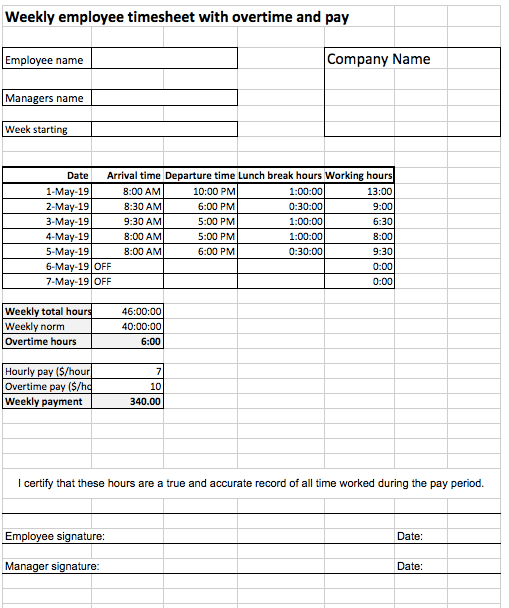Timesheets have been around since the industrial revolution in the 19th century. Over time, they have changed their form, but their aim remained the same: to track employees’ work hours and determine their monthly payment.
Definition
A timesheet is a written record of the exact time an employee arrived and left work. In the older days, timesheets were made of paper or cardboard and stamped by administrative personal or time clock machines. While you can still find paper timesheets in some offices, most companies use digital timesheets created using text editors, Excel templates, dedicate software, online apps, or even access cards.
The benefits of timesheets
The main benefit of timesheets is maintaining accurate records of the time an employee arrived and left work. They are the easiest way to know how many hours an employee has worked. And based on these records, one can compute monthly wage.
Nowadays, monthly work hours are automatically calculated based on digital timesheets.
But timesheets have other benefits too. They eliminate mistakes and contradictions between staff and the management team. Timesheets also record overtime hours, which allows employees to be paid fairly for their work. By maintaining a transparent tracking of the work hours, the management team can combat burnouts and absenteeism. Timesheets are a good indicator of the efficiency of workers and stressful periods too.
By incorporating digital timesheets into the payroll system, a company can automatically manage remote teams, freelancers, and part-time employees.
How to use a timesheet?
Whether your company uses a paper or a digital timesheet, there are several ways to use it:
- The timesheet is updated by employees.
- The timesheet is updated by the administrative staff.
- The timesheet is automatically updated by reading employees’ access cards.
- The timesheet is automatically updated based on the clock-in punches.
A timesheet can cover a day, a week, two weeks, a month, or a specific period. At the end of the period specified by the timesheet, a member of the administrative team computes the number of hours an employee has worked for and communicated the results to the accounting department.
Integrated digital systems perform these operations automatically and provide real-time situations. In practice, the timesheet app reminds the employee to verify entries and submit and submit it for the line manager for approval. The supervisor checks the regular hours, and if there are overtime or additional absences and tries to avoid discrepancies like work within non-working days or multiple days of overtime, although the workload was not high.
Paper versus digital timesheets
One may say that’s no need for paper timesheets anymore. However, some companies prefer to use them because they’re accessible to all employees regardless of their computer skills, don’t need power or dedicated devices, and can be used in very remote locations. Moreover, for companies with few employees, the costs of implementing a digital system are not justified.
On the other side, large multinational companies with thousands of employees can’t work with paper timesheets. They need fast and efficient systems to track employees’ work hours. For them, costs aren’t an issue. They usually use integrated systems that track work hours, overtime, lunch breaks, and leave days and automatically communicate data to management, HR, and accounting departments.
As a result, before choosing between paper and digital timesheets, consider your company’s profile, number of employees, budget, and IT resources.
What features should digital timesheets have?
If you decide you need a digital timesheet solution, consider the following features:
- Employee self-service with online clock-in – Employees can clock in and out from their desk even when they work from home or in remote locations.
- Integration with the payroll system – You can skip manual computations because the system automatically communicates data to the accounting department.
- Integration with the time-off manager – All employees’ data should be in one place, easy to manage and analyze. Using an integrated system allows the employees to manage their working hours and leave days in seconds.
- Tailored calendars – When you’re in charge of employees working around the world you have to deal with public holidays, time zones, different leave policies, and different time schedules. Timesheet software should manage all this for you and give you the right tools for it.
- Secure logins – Software should have secure connections and credentials for each employee. It should also accept different types of accounts and permissions.
- Automatic reports – Timesheet software solutions should provide automatic working hour time reports making overall and individual statistics efficient and easy to follow.
How does digital timesheet software work?
Digital timesheet software can work offline (only in your company’s intranet) or online. You can choose from desktop software, online services, and mobile apps. You can choose to store data on your local servers or in the cloud. But regardless of the technical solution you choose, timesheet software provides customizable tools for time tracking.
Employees can use timesheet software to enter daily work hours, over time, the exact amount of time they spent with a task or project, leave days, and personal time off. Each employee has unique credentials to access their accounts. The software automatically generates reports and transmits data to the HR and accounting departments. Also, the software periodically creates backups and safely stores the employees’ data. And, of course, it doesn’t make mistakes or miscalculations.
In conclusion
Timesheets have been around for a long time and they’ll continue to be. So choose the best timesheet for your company and create a transparent and productive workflow. It’s important to use a timesheet that suits your employees’ work profile and skills, provides easy ways to enter data, and can be adapted to your company’s hierarchy.
